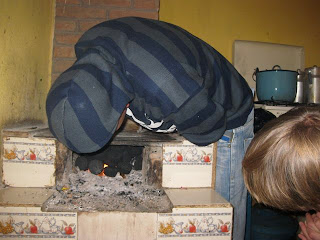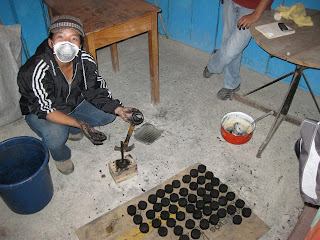



















Ok, time is just passing by way too quickly. We've been making a lot of progress on the briquette project.
First, I wanted to enclose the pictures I mentioned before of all the people carrying firewood. This is a huge loss of time and money for the families. All are involved: men, women and children. The people do their best like I mentioned in my other post, but to show how they struggle, I have a few pics of a man helping the lady adjust her load. There is a picture of a kid adjust his load of firewood. I am missing pictures of the elderly women carrying similar heavy loads.
We went on a short hike this morning and passed a family of five trekking down with their load of wood. The first three pictures were taken during this hike.
Back to the update: we have completed four batches - two were made with corn cobs (batches 1 and 3) and two were made with corn stalks (batches 2 and 4). I like the corn stalks better for a few reasons:
1. They're more readily available. Families keep dried corn on the cob in their house and de-kernel them (is that a word?) as they need it to make the masa for their tortillas. So, it's hard to get a large supply of corn cobs at one time. Corn stalks however, are currently lying in the fields in abundance. We have a small window to collect large batches of them though. Folks are starting to burn their fields to clear them and prepare for the next planting season.
2. They're easier to burn. Corn cobs take longer to burn. We're still working on our process and timing to be able to yield more carbonized pieces rather than unburned cobs/ stalks, but we get better yield with corn stalks.
3. They're easier to pulverize. Stalks are just easier to step on/ beat/ grind into powder. Corns cobs are really hard some times.
We burned the first two batches on a grill to barbecue food on an excursion to the waterfalls. It was a great way to prove out the charcoal works really well for the grill. We wanted to see if there was a difference between performance in corn cob based briquettes vs. corn stalk based briquettes. We didn't see any difference as we were grilling the food. That was good to know.
Next, I wanted to try the briquettes in the estufa mejorada -- the improved stoves (picture attached). Our group sells a simple stove with metal plancha and chimney to reduce the amount of smoke in the house, to use less wood, and to decrease the danger of children getting burns from playing around an open fire. I wanted to see if how the carbon works -- if it gets hot enough, if it can perform as well as firewood -- to see if it can be a viable alternative to firewood. Good news is that it gets hot. Hot enough for the ladies to be able to make tortillas on the plancha. Apparently that is good criteria. If the metal plancha doesn't get hot enough, the tortillas don't rise. So we passed that test. Bad news is that in the first 15 minutes after lighting the charcoal, Ricardo's kitchen was filled with smoke. That's not acceptable. There is a chance their chimney was blocked so we're going to clean it and then try burning batch 4 in their estufa again (just made last week - 96 pcs, best yield yet - pics of the process attached). I need to reevaluate what the market opportunity is if it doesn't work with the stoves. There are still many families who can't afford stoves so if they cook on an open flame, this coal would still work for them.
I'm not too familiar with how one goes about assessing a market opportunity, but that's what my next goal is. Also, we need to quickly secure more corn stalks (if it's worth) because our time is running out. I'm also asking Ricardo and his brothers (who are also agricultores on the weekend) to think about other agricultural waste products we can use to make charcoal.
I extended my stay so that I could work on this project. I only have another 6 weeks left here in Guatemala, so I feel a sense of urgency to scope this project out properly. Wish me luck!
